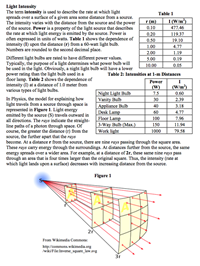 Light Brightness
Light Brightness
Resource:
The Science Reasoning Center: Light Brightness
Grade Level: High School
Description:
This passage uses two different tables to present information regarding the relationship between light intensity and the distance from the source and between light intensity and the power of the source at fixed distances from the source. A model for understanding the inverse square law is discussed. Questions target a student's ability to select data from a table (or two), to interpolate and extrapolate from information given in a table, to draw conclusions consistent with presented information, to identify the relationship among the variables, and to identify statements that are consistent with both the model and the data.
Performance Expectation:
HS-PS4-3 Evaluate the claims, evidence, and reasoning behind the idea that electromagnetic radiation can be described either by a wave model or a particle model, and that for some situations one model is more useful than the other.
This activity aligns with the three dimensions of the Next Generation Science Standards in the manner described below:
| Electromagnetic Radiation (HS-PS4.B.1): Electromagnetic radiation (e.g., radio, microwaves, light) can be modeled as a wave of changing electric & magnetic fields or as particles called photons. The wave model is useful for explaining many features of electromagnetic radiation, and the particle model explains other features. |
While both the wave model and particle model can be used to illustrate that light decreases in intensity as it moves further and further from its source, this passage explores how the particle model supports this fact. In this passage, rays are used to indicate the straight line paths of photons through space. The greater the distance from the source, the further apart the rays become. As such, the intensity (rate at which light lands upon a surface) decreases with increasing distance from its source. |
| Scale, Proportion, and Quantity: Algebraic thinking is used to examine scientific data and predict the effect of a change in one variable on another (e.g., linear growth vs. exponential growth). |
This passage explores how light intensity is directly related to the power of the light source and inversely related to the square of the distance from the source. Rather than stating these relationships directly, however, data is presented to illustrate each of these relationships. Using the data presentations, the student must employ algebraic thinking to predict how each of these two variables (power and distance) affects the intensity of light. |
| Analyzing and Interpreting Data: Analyze data using computational models in order to make valid and reliable scientific claims. |
This passage offers two tables of experimental data. The first leads students to explore the relationship between light intensity and distance from a source; the second helps students understand the relationship between light intensity and the power of the source at a fixed distance. Questions target a student's ability to select data from one or both tables, to interpolate and extrapolate from information given in a table, to draw conclusions consistent with presented information, to identify the relationship among the variables, and to identify statements that are consistent with both the particle model and the data. |
| Engaging in Argument from Evidence: Make and defend a claim based on evidence about the natural world that reflects scientific knowledge, and student-generated evidence. |
Several of the passage-end questions ask students to identify a correct claim based on textual information from the passage as well as evidence from the data collected. As an example, Question 10 reads, “The planet Neptune is approximately 30 times further from the Sun as the Earth is from the Sun. Which statement accurately compares the intensity of light from the sun on the surfaces of these two planets?” In order to identify such a claim, students must use textual information and one of the data presentations to arrive at a viable conclusion. |
| Using Mathematical and Computational Thinking: Use mathematical representations of phenomena to support claims. |
As light intensity varies directly with the power of the source and inversely with the square of the distance from the source, several passage-end questions require computational thinking as students apply these relationships to new situations. In a particular question, for example, the light intensity is given for a particular distance from a source. The student must apply what he has learned to determine the intensity of this light at two other distances. Another question requires the student to extrapolate in order to predict the intensity of light landing on a surface 1 meter away from a higher wattage light source than those used in the experimental data. |
Associated Reading from The Physics Classroom
View Infographic.
(Coming Soon)
Search the NGSS Corner
Maybe you're looking for something really specific that pertains to a desired topic and emphasizes one or more of the listed NGSS dimensions. Why not try a search of this section of our website? Simply select from one or more of the pull-down menus and click Search This page will reload and a collection of possibilities will be displayed in this section of the page and sorted by relevancy.